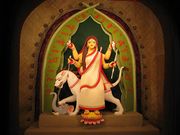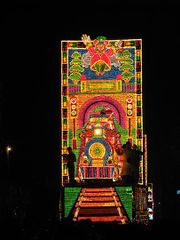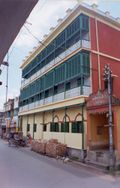Chandannagar
| Chandannagar | |||||
| — city (general) — | |||||
|
|
|||||
| Coordinates | |||||
| Country | |||||
| State | West Bengal | ||||
| District(s) | Hooghly | ||||
| Population • Density |
150,000 (2001[update]) • 7,500 /km2 (19,425 /sq mi) |
||||
| Time zone | IST (UTC+5:30) | ||||
| Area | 20 km2 (8 sq mi) | ||||
|
Codes
|
|||||
Chandannagar, formerly known as Chandernagore or Chandernagar (French: Chandernagor), (Bengali: চন্দননগর Chôndonnôgor) is a small city and former French colony located 30 kilometres (19 mi) north of Kolkata, in West Bengal, India. It is head quarters of a subdivision in Hooghly District. It is a part of the area covered by Kolkata Metropolitan Development Authority.[1] Located on the Hooghly River, the city has been able to maintain a separate identity different from all other cities and abide by her own characteristics. The total area is a meagre 19 square kilometres (7.3 sq mi) having a population of over 150,000. Chandannagar is connected to Kolkata by railway, roadways and river and it takes about an hour to reach there by car.
Contents |
Origin of name
The name Chandannagore is possibly derived from the shape of the bank of the river Ganga which is bent like a half moon (Bengali: Chand means moon and Nagar implies city). Others believe it might have been taken from the flourishing trade and business of sandal wood (Bengali:Chandan) at that time. One more reason behind the name is, in Chandernagore there is a temple of Goddess 'Chandi'. So somebody believes that it might come from there. But earlier people knew the place by the name Farasdanga as it was a French colony (Bengali: Farasi means French, danga means land).
History
Chandannagar was established as a French colony in 1673, when the French obtained permission from Ibrahim Khan, the Nawab of Bengal, to establish a trading post on the right bank of the Hughli River. Bengal was then a province of the Mughal Empire. It became a permanent French settlement in 1688, and in 1730 Joseph François Dupleix was appointed governor of the city, during whose administration more than two thousand brick houses were erected in the town and a considerable maritime trade was carried on. For a time, Chandannagar was the main center for European commerce in Bengal.
In 1756 war broke out between France and Great Britain, and Colonel Robert Clive of the British East India Company and Admiral Charles Watson of the British Navy bombarded and captured Chandannagar on 23 March 1757. The town's fortifications and many houses were demolished thereafter, and Chandannagar's importance as a commercial center was eclipsed by that of Calcutta just downriver. Chandernagore was restored to the French in 1763, but retaken by the British in 1794 in the Napoleonic Wars. The city was returned to France in 1816, along with a 3 sq mi (7.8 km2) enclave of surrounding territory. It was governed as part of French India until 1950, under the political control of the governor-general in Pondicherry. By 1900 the town's former commercial importance was gone, and it was little more than a quiet suburb of Calcutta, with a population of 25,000 (1901). The European town was noted for its clean wide thoroughfares, with many elegant residences along the riverbank.
Independence
India became independent of Britain in 1947, and in June 1948 the French Government held a plebiscite which found that 97% of Chandannagar's residents wished to become part of India. In May 1950, the French allowed the Indian government to assume de facto control over Chandannagar, officially ceding the city to India on 2 February 1951. De jure transfer took place on 9 June 1952. On 2 October 1955 Chandannagar was integrated into West Bengal state.
Places of tourist interest
- Chandannagore Strand
- A beautiful tourist spot along the banks of the river Ganga. It is a superbly decorated pavement studded with lights surrounded by lushy green trees. It is about 1 km (0.62 mi) in length and 7 metres (23 ft) in width, and many buildings of historical importance surround the spot. It is very popular visiting spot of the local people and the tourists would love to stroll along enjoying the mild breeze and watching the small boats sail by. Along the strand are present Vivekananda Mandir (a meditation centre) and a protruding structure into the river Ganga. This is supposed to be the best decorated bank of the river along its entire length of 2,500 km (1,600 mi).
- Chandannagore Museum and Institute (Institut de Chandernagor)
- One of the oldest and finest museums of the entire region. It boasts a beautiful collection of French antiques (like cannons used in Anglo-French war, wooden furniture of 18th century, etc.) which are difficult to find anywhere else in the world. The institute still teaches French through regular classes.
- The Sacred Heart Church of Chandannagar (l'Eglise du Sacré Cœur)
- The church stands for over two centuries to mark the beauty of the architecture during the French period — a good place to visit for the historians and tourists alike. The remains of the Church of St. Louis is also an attractive tourist spot.
- The Underground House (Patal-Bari)
- The building is another beautiful example of the advancement in the knowledge of architecture and the aesthetic sense of the people of those earlier days. Its lowest floor is submerged in the River Ganga. The Nobel laureate Rabindranath Tagore frequently visited the place and appreciated a lot about the building. He felt that the place influenced him to a large extent and broadened his intellectual capabilities. He mentioned Patal-bari in many of his famous novels. The famous social reformer Pandit Iswar Chandra Vidyasagar also stayed in the building. The house was owned by the ruling family of nearby Bansberia.
- Ancient temples
- Nandadulal Temple, built in 1740 by Indranarayan Roychoudhury presents an excellent example of ancient Indian sculptures. There are many fascinating temples devoted to Kali, Shiva and other deities which show marks of brilliant craftsmanship and artistic taste.
- Residences of famous personalities
- The place hosts a galaxy of famous personalities who had strong impact not only on contemporary society but also affected Indian History. The revolutionary leader Rash Behari Bose's paternal house stands at Fatokgorah. Kanailal Datta and the great social reformer Sri Harihar Sett were also natives of Chandannagar. Upendra Nath Bandopadhyay, the founder of Dynak Basumoti a daly bengali news paper, Mr. Jatindra nath Bandopadhyay were among the other renowned personalities of this historic town.
- Nritya Gopal Smriti Mandir
- Built by Sri Harihar Sett, and donated to the people of Chandannagore. This building still serves as a theatre hall and a library. It was first of its kind in the entire locality.
Chuti and New Digha are two very popular amusement parks situated in the western part of Chandannagar.
Roads and transport
- By road
- Chandannagore is 37 km (23 mi) by road from Kolkata via G.T.Road or Delhi road. Taxis and private cars in Kolkata are easily available to approach Chandannagore.
- By rail
- Local trains from Howrah through Howrah Burdwan Eastern Railway main line run very frequently (peak frequency one train every 10 or 12 minutes). Many important express and passenger trains halt here.
- By air
- Nearest airport is at Kolkata (Kolkata Airport), which is airlinked with all major Indian and international cities. Chandannagore is only 40 km (25 mi) by road from the airport. Please check Flight Schedules from the airport.
- By water
- Government of West Bengal (West Bengal Surface Transport Corporation) operates river services across river Hooghly (Ganga) and also between Chandannagore and Kolkata and Belur.
Heritage and Culture
Jagaddhatri Puja is a major socio cultural event in this region.
History
The ancient history of Jagadhatri Puja in Chandannagar is unknown even today. It is believed that Indranarayan Chowdhury introduced the Jagadhatri Puja in Chandannagar in the manners similar to Raja Krishnachandra of Krishnanagore. The time of beginning of Jagadhatri Puja in Krishnanagore was 1762. Indranarayan Choudhury died in 1756. So Indranarayan Choudhury by no means introduced the Jagadhatri puja in Chandannagar. The beginning of Jagadhatri puja in Chandannagar probably dates back earlier than 1750. Indranarayan Choudhury performed the Jagadhatri puja at his own house in Chandannagar, at the time Krishnachandra used to come to borrow money from Indranarayan Choudhury. Perhaps Krishnachandra was attracted to greatness of Jagadhatri at this time.
Rituals and the idol

The formal difference between goddess Durga and Jagaddhatri lies in Mayatantra and Jagaddhatri is mentioned with reference to Durga in Krishnanda's Tantrasaar. The rule to perform the special puja of the goddess on the ninth lunar day of the light fortnight in the Bengali month of Kartick has been mentioned in Krityatattarnab by Srinath Acharyachuramoni of the 15-16th century. The four-handed goddess is carried by the lion everywhere, an elephant lies at the feet of the lion. The idol has an old fashioned shaping, i.e. the face cutting is of a longish pattern; it has large eyes spread up to the ears and the four hands display conch, discus, shaft and bow respectively. The snake is her sacred thread. One of the main attraction of Jagaddhatri idol of Chandannagar is the ornamental decoration of the goddess with shola (stick) and beautiful canvas of mats with painting at the back of the image.
Public display

The number of community pujas in Chandannagar, Bhadreswar and Champdani Municipal areas cross 190. Of these, 132 Puja committees in different localities in Chandannagar and Bhadreswar are affiliated to the Chandannagar Central Jagadhatri Puja Committee. The Central committee renders all possible assistance to its constituents in getting permissions and clearances for holding Puja. The immersion procession is really memorable and enjoyable sight to witness in which lakhs of people participate from far and near. The beautiful decorated tall images loaded on trucks are taken around the city in a procession.
Education
It is believed that there was a small school founded by the missionaries for the Bengali boys on the south of Chandannagar where there is a convent now. Bengali and French were freely taught there. The former Dupleix college was also established by the missionaries. Later Dupleix college was known as Dupleix school from 1901. The school was renamed Kanailal Vidyamandir after the name of the revolutionary Kanailal Dutta, a student of this school, on 17 May 1948 just before the liberation from the French rule. The Centenary ceremony of the school was inaugurated by Dr. Brajakanta Guha, the Vice-Chancellor of University of Burdwan on its first day.
Banga Vidyalaya is another well known school of Chandannagar. It was established on Baisakh 20, 1288 (Bengali calendar) with three boys only on roll at a small rented house of Kanailal Khan at Barasat Tematha. There were two primary schools, one established in 1885 by Durga Charan Rakshit after his own name. The other one was founded by Harihar Sett after his father's name as Nritya Gopal Sett Prathamik Vidyalaya.
Sri Aurobindo Vidyamandir is one of the most renowned School of this town and is the only English medium School of the town for Boys. It is quite famous in the district as it is one of the very few English medium schools that are affiliated to the West Bengal Board of Secondary Education (WBBSE).
Krishnabhabini Narisiksha Mandir was established in 1926 by Harihar Sett after his mother's name. This was the first girl's high school in the district. Besides there is an educational institution established and managed by Prabartak Sangha. There was an arrangement for both boys and girls to stay and receive education here. Convent for girls at Chandannagar. It was the oldest educational institution in the area. Through the years the school has retained its excellent tradition of exemplary dedication which is reflected in its excellent result in ICSE exam. The building which first bore the name St. Joseph's Convent has now branded into buildings on every side of the campus. These buildings have been erected to accommodate the sister institutions, St. Anthony's High School, the dispensary and its annexe, St. Mary's school, all under the management of St. Joseph's Convent.
List of boys' schools in Chandannagar

- Sri Aurobindo Vidyamandir (English medium)
- Kanailal Vidyamandir
- Kanailal Vidyamandir (French)
- Durga Charan Rakshit Bangavidyalaya
- Chandannagore Banga Vidyalaya
- Adarsa Shikshalaya
- Prabartak
- Ganges Gurukul (Coed)
- Khalisani Vidya Mandir
- Durgamoyee Academy
- Narua Siksha Niketan
List of girls' schools in Chandannagar
- St. Joseph's Convent (English Medium)
- LalBagan Balika Vidyalaya
- Ushangini Balika Vidyalaya
- Prabartak Sangha
- Indumati Girls High School
- Khalisani Nari Siksha Mandir
- Narua Bholanath Das Nari Siksha Mandir
- St. Anthony's High School
- Krishna bhabini Narisikha Mandir
RISH AUROBINDO BAL KENDAM
Headline text
List of colleges in Chandannagar
- Chandannagar Govt. College
- Khalisani Mahavidyalaya
- Institute of Education (P.G.) for Women, Chandernagore
- Women's Polytechnic College
Famous Art School in Chandannagar
“RONG O TULI” one of the renowned Art School at Chandannagore since 1960. Celebrating Golden Jubilee this year. Founder famous seiner artist Sri Sunil Chattopadhayay. Presently Teacher in Charge Mr.Shuvendu Banerjee,running at Ushangini Balika Vidyalaya, Tematha, Shivtala, Chandanagore, Dt: Googhly. India.
First drawing school of Chandernagore was SISHU KALA BHAVAN Estd: 1946. Founded by Sri Bankim Bandyopadhyay in Kanailal Vidyamandir (French Section). Many talented painters started their carrier from there. The first International prize in painting was won by Sri Patit Paban Das from Sishu Kala Bhavan in 1956 in West Bengal. Other Famous Artists were Sri Madhab Ch Basak, Sri Gora Chand Das, Sri Ajit Das, Sri Hari Narayan Das etc.
List of newspapers and magazines
This is a list of publications from Chandannagore in both the French era and modern times:
- Le Petit Bengali: The first French newspaper published from Chandannagore. First publication year 1879.
- Vive la République: Weekly newspaper. First publication on 1882. Bengali version named Prajabandhu. Published by Bayas Press, 15 Rue General Martin, Chandernagore.
- Dhumketu: Weekly newspaper in Bengali. First published in 1886.
- Chandannagore Prakash: Another weekly newspaper in Bengali. First publication in 1892.
- Pravartak: Bi-monthly magazine in Bengali. Published by Governor of Chandernagore. First published on 16 January 1916.
- Nabasangha: Weekly magazine in Bengali. First publication in 1920 from Pravartak Publishing House.
- Le Matribhumi: Bi-monthly magazine. First appeared on 8 January 1927.
- Pravartak: Fort-nightly journal in English on constructive nationalism. First published on 19 September 1931.
- Sevak: Weekly bengali newspaper. First published on 21 March 1932.
- Prajashakti: Bi-monthly magazine. First appeared on 13 January 1937.
- Swadhinata: Fortnighty journal. Publication started from 26 May 1945.
- Jai Hind: Weekly patriotic newspaper. First published on 13 April 1947.
- Jugantar: Bi-monthly magazine. First appeared on 19 April 1947.
- Maitri: a famous Bengali Sahityo Patrika (Literary Magazine) (Bi-annual) Edited by Shuvendu Banerjee, Since 1995.Editorial Office: P.O. Gondal Para, Stghat, Chandannagore, Dt: Hooghly. India.
Geography
Chandannagar is located at .[2] It has an average elevation of 10 metres (33 ft).
Demographics
As of 2001[update] India census,[3] Chandannagar had a population of 162,166. Males constitute 52% of the population and females 48%. Chandannagar has an average literacy rate of 78%, higher than the national average of 59.5%; with male literacy of 82% and female literacy of 74%. 8% of the population is under 6 years of age.
Politics
Current MLA from Chandannagar assembly constituency is Shibaprasad (Ratan) Bandopahdyaya of CPI(M), who won the seat in State elections of 2006. Kamal Mukherjee of INC had won this seat in 2001 and in 1996. Sandhya Chatterjee of CPI(M) was elected in 1991 and in 1987. Bhabani Mukherjee of CPI(M) was MLA from this seat in 1982 and in 1977.[4]
Chandannagar assembly constituency is part of Hooghly (Lok Sabha constituency).[5]
See also
- French India
- French colonial empire
- Municipal Administration in French India
References
- ↑ "Base Map of Kolkata Metroploitan area". Kolkata Metroploitan Development Authority. http://www.cmdaonline.com/kma.html. Retrieved 3 September 2007.
- ↑ Falling Rain Genomics, Inc — Chandannagar
- ↑ "Census of India 2001: Data from the 2001 Census, including cities, villages and towns (Provisional)". Census Commission of India. Archived from the original on 2004-06-16. http://web.archive.org/web/20040616075334/http://www.censusindia.net/results/town.php?stad=A&state5=999. Retrieved 2008-11-01.
- ↑ "State Elections 2006 - Partywise Comparision for 182-Chandannagar Constituency of West Bengal". Election Commission of India. http://eci.gov.in/electionanalysis/AE/S25/partycomp182.htm. Retrieved 25 October 2008.
- ↑ "Assembly Constituencies - Corresponding Districts and Parliamentary Constituencies" (PDF). West Bengal. Election Commission of India. http://archive.eci.gov.in/se2001/background/S25/WB_Dist_PC_AC.pdf. Retrieved 2 October 2008.
Furthur reading
- [|Hill, Samuel Charles] (1903) (HTML, txt). Three Frenchmen in Bengal: The Commercial Ruin of the French Settlements in 1757. Project Gutenberg. e-text #10946. http://www.gutenberg.org/etext/10946. Retrieved 25 April 2007.
- [|Strang, Herbert] (HTML, txt). In Clive's Command: A Story of the Fight for India. Project Gutenburg. e-text #16382. http://www.gutenberg.org/etext/16382. Retrieved 25 April 2007.
External links
- 300 years of Chandannagar (1696-1996)
- Geocities site about Chandannagar
- Institut de Chandernagore - official website
- Indian Ministry for External Affairs - 1951 Treaty of Cession
- La présence française à Chandernagor (1688-1950) (French)
- East Meets West by A. Chatterji
- Banglapedia page on Chandannagar
- Yahoo! Education page on Chandannagar
- Stereotype photo (poverty etc) Gallery of Chandannagar on TrekEarth
|
|||||||||||||||||||||||||||||||||||||||||||||||||||||||||||||||||||||||||||||||||||||||||||||||||||||||||||
|
||||||||||||||||||||
|
|||||||||||


